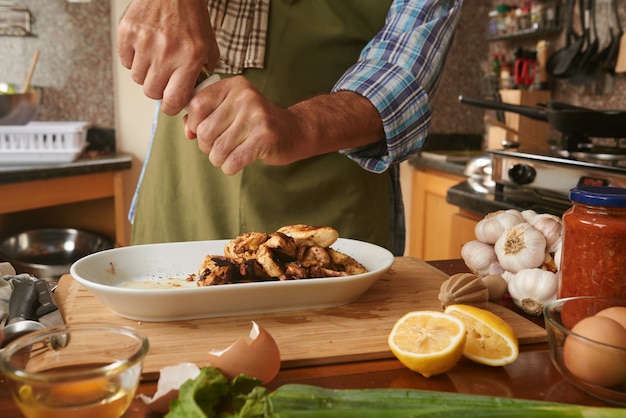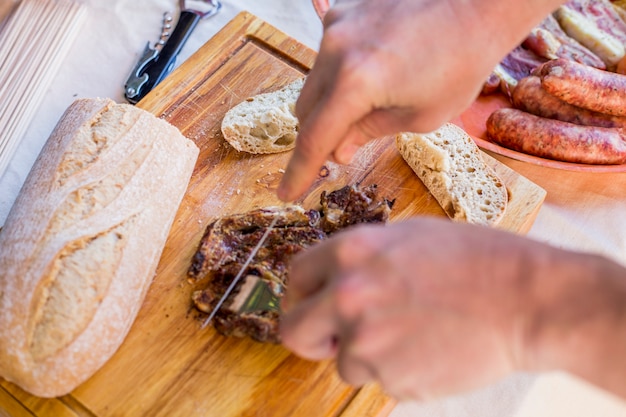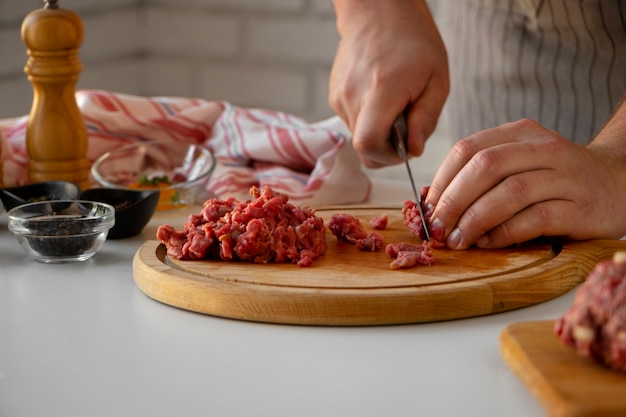(Part 1) Choosing the Right Cut: Navigating the Lamb Leg Options

Personally, I have a soft spot for the whole leg. I love the fact that it’s got the bone in. It adds so much flavour to the meat, and it looks absolutely fantastic when it's served up on the table. But, if you're looking for something a bit less intimidating to carve, the boned and rolled leg is a fantastic choice.
Choosing Your perfect lamb Leg: Key Considerations
When you're browsing the butcher's counter, there are a few key factors to consider when selecting your lamb leg:- Size: How many people are you feeding? A whole leg will easily feed a large gathering, while a saddle is perfect for a smaller group.
- Bone in or boned: Do you want the bone in or out? If you want a more flavourful and impressive dish, go for the bone-in option. If you're looking for something easier to carve, go for boned and rolled.
- Fat content: Look for a lamb leg that has a good amount of fat marbling. This will ensure that the meat is incredibly tender and flavorful.
(Part 2) Preparing the Lamb Leg: Getting Ready for Cooking

The first thing I always do is trim off any excess fat. This helps prevent the lamb from being overly greasy and ensures a more even cooking process. Then, I like to tie the lamb leg up with some string. This helps keep it in shape while it's cooking, ensuring a beautiful, even presentation. If you're using a boned and rolled leg, it’ll already be tied up for you. Finally, I season the lamb leg generously with salt, pepper, and any other herbs and spices that I’m feeling inspired by. I often use a mix of rosemary, thyme, and garlic – they just work so well with the lamb!
Essential Tips for Preparing a Lamb Leg
Here are a few key tips to keep in mind for perfect lamb leg preparation:- Pat the lamb dry: This simple step ensures that the skin of the lamb will crisp up beautifully.
- Don't overseason: A little goes a long way when it comes to herbs and spices. You want to enhance the natural flavour of the lamb, not overpower it.
- Let the lamb rest: After cooking, let the lamb rest for at least 10 minutes before carving. This allows the juices to redistribute throughout the meat, resulting in more tender and flavourful meat.
(Part 3) slow roasting: The Classic lamb leg cooking Method

The key to slow roasting is to cook the lamb at a low temperature for a long time. This allows the meat to cook evenly and slowly, resulting in a melt-in-your-mouth texture. I usually roast my lamb leg at 140°C (285°F) for around 3 hours. The meat will be incredibly tender and juicy, perfect for slicing and serving.
Slow Roasting in the Oven
- Preheat your oven to 140°C (285°F).
- Place the lamb leg in a roasting tin and add some vegetables, like carrots, onions, and potatoes. These will not only add flavour to the meat but also create a delicious gravy.
- Roast the lamb for 3 hours, or until it's cooked through. You can check if it's cooked by inserting a meat thermometer into the thickest part of the meat. The internal temperature should be around 63°C (145°F) for medium-rare.
Slow Roasting in a Slow Cooker
- Place the lamb leg in the slow cooker and add your chosen vegetables.
- Pour over some stock or wine – this will help create a luscious gravy and add even more flavour.
- Cook on low for 6-8 hours, or on high for 3-4 hours. Remember to check the meat thermometer to ensure it reaches the desired internal temperature.
(Part 4) Barbecuing: A Summery Feast with Smoky Flavors
There’s just something truly special about barbecued lamb. The smoky flavour, the char marks, and that incredible aroma wafting through the air – it’s the perfect summer meal.When barbecuing lamb, it's important to use a good quality charcoal or gas barbecue. You also need to make sure the barbecue is nice and hot. If you can get those grill marks just right, you're in for a real treat!
Barbecuing Tips for Succulent Lamb
- Preheat your barbecue to medium-high heat. You want that heat to sear the lamb beautifully.
- Season the lamb leg with your favourite barbecue rub. I love using a mixture of paprika, cumin, garlic powder, and brown sugar. But, you can get creative with your flavours!
- Cook the lamb for 10-15 minutes per side, or until it's cooked through. Remember to rotate the lamb so that it cooks evenly.
- You can wrap the lamb leg in foil for the last hour of cooking to ensure it stays beautifully moist.
(Part 5) Pan-Seared Lamb Leg: A Quick and Delicious Option
If you’re short on time but still want a delicious lamb leg, then pan-searing is the way to go. This method gives you a crispy exterior and a juicy interior – a winning combination!I often pan-sear my lamb leg with some olive oil, garlic, and rosemary. It's a simple but flavoursome dish that's perfect for a weeknight meal. You can serve it with roasted vegetables or a salad – it's incredibly versatile!
Pan-Searing Instructions for a Crispy Exterior
- Heat a large frying pan or cast-iron skillet over medium-high heat. You want that pan to be good and hot!
- Add some olive oil to the pan and heat it up. Let the oil shimmer before adding the lamb.
- Season the lamb leg with salt, pepper, and any other herbs and spices you like. You can use the same seasonings you would for other cooking methods, or get creative and try something new.
- Sear the lamb leg for 5-7 minutes per side, or until it's browned and crispy. Be careful not to overcook it.
- Once the lamb is seared, you can either serve it straight away or finish cooking it in the oven. If you want to ensure the meat is cooked through, you can pop it in a preheated oven for about 15-20 minutes.
(Part 6) marinated lamb leg: Infusing Extra Flavour
Marination is a fantastic way to infuse your lamb leg with even more flavour. You can use a simple marinade of olive oil, lemon juice, and garlic, or get creative and add other ingredients like herbs, spices, and even fruit. The possibilities are endless!I often use a marinade of olive oil, red wine vinegar, Dijon mustard, garlic, and rosemary. It’s a combination that adds a touch of sweetness, tanginess, and a lovely herbaceous aroma. I let the lamb marinate in the fridge for at least 4 hours, but overnight is even better. The longer it marinates, the more flavour it absorbs.
Marination Techniques for Delicious Lamb
- Use a resealable bag for marinating. This allows the marinade to coat the lamb leg evenly, ensuring that every bit of the meat gets infused with flavour.
- Marinate the lamb for at least 4 hours, or up to overnight. The longer you marinate, the more flavourful your lamb will be.
- Before cooking, remove the lamb from the marinade and pat it dry. This helps to ensure that the lamb browns beautifully and develops a crispy exterior.
(Part 7) The Importance of Resting: Giving Lamb Leg a Break
This is a crucial step that often gets overlooked but is essential for achieving the best results. Allowing the lamb to rest after cooking is crucial for achieving a truly tender and juicy dish.The resting period allows the juices to redistribute throughout the meat, resulting in a more tender and flavorful dish. I usually let my lamb leg rest for 10-15 minutes before carving it.
Benefits of Resting:
- More tender and flavorful meat.
- Easier to carve – those juices make the meat more tender, so it slices beautifully.
- Less juice loss. When the lamb rests, the juices are reabsorbed, minimizing the amount of juice that runs out when carving.
(Part 8) Delicious Accompaniments: Perfect Partners for Lamb Leg
No lamb leg is complete without the perfect accompaniments. Here are a few of my all-time favourites that are guaranteed to elevate your lamb leg experience:- Roasted vegetables: Carrots, potatoes, onions, and even Brussels sprouts go wonderfully with lamb leg. They complement the flavour of the lamb and add a beautiful visual contrast to the plate.
- Mint sauce: This is a classic pairing for lamb. The refreshing and slightly tangy flavour of mint sauce cuts through the richness of the lamb, creating a perfect balance of flavours. You can easily make your own mint sauce or buy it pre-made.
- Gravy: Make a delicious gravy using the pan juices from the roast or barbecue. Add some flour and stock to thicken it up. The flavour of the gravy is intensified by the browning that occurs on the lamb and vegetables while cooking.
- Side salads: A fresh salad is the perfect way to balance the richness of the lamb leg and add a burst of freshness to your meal. Choose ingredients like leafy greens, tomatoes, cucumbers, and a light vinaigrette.
- Bread: A crusty bread is great for soaking up all the delicious juices from the lamb and its accompaniments.
(Part 9) Serving Suggestions: Presenting a Lamb Leg Feast
There are so many ways to serve a lamb leg, making it perfect for any occasion. You can keep it simple and serve it with a few roasted vegetables, or go all out with a more elaborate spread.I like to carve the lamb leg at the table and serve it with a big dollop of mint sauce and a selection of roasted vegetables. It creates a truly impressive and interactive dining experience. I also love to serve it with a side salad and some crusty bread. It’s a delicious and balanced meal that’s perfect for sharing with friends and family.
Serving Tips for Impressing Your Guests:
- Use a sharp carving knife to slice the lamb into thin slices. This ensures that the meat is sliced cleanly and evenly.
- Serve the lamb leg with your chosen accompaniments. The perfect combination will depend on your chosen cooking method and personal preferences.
- Don't forget to offer your guests some extra mint sauce, gravy, or salad. It’s always a good idea to have plenty of options on hand.
(Part 10) Leftovers: Don't Throw Them Away!
Ever found yourself staring at a pile of leftover lamb leg? Don't despair! Leftovers are a great opportunity to create new meals, and lamb leg is perfect for this.Here are a few ideas for using up leftover lamb leg, turning it into delicious and satisfying dishes.
Leftover lamb recipes:
- Lamb sandwiches: Slice the leftover lamb thinly and use it for sandwiches with your favourite fillings, like lettuce, tomato, and mayonnaise. It's a fantastic way to use up leftovers for a quick and easy lunch or dinner.
- Lamb salad: Combine the leftover lamb with chopped vegetables, herbs, and a light dressing. This is a fresh and light meal that's perfect for warmer weather.
- Lamb soup: Use the leftover lamb and some of the pan juices to make a hearty and flavorful soup. Add some vegetables and lentils for a comforting and satisfying meal.
- Lamb pasta: Add the leftover lamb to your favourite pasta dish. You can toss it with a creamy sauce or a tomato-based sauce for a quick and easy meal.
(Part 11) FAQs: Answering Your Burning Questions about Lamb Leg
1. How long does it take to cook a lamb leg?
The cooking time for a lamb leg will vary depending on the size of the cut and the cooking method you choose. As a general rule, a whole lamb leg will take around 3 hours to slow roast in the oven at 140°C (285°F). If you're using a slow cooker, it might take up to 8 hours on low. For barbecuing, you'll need to cook the lamb for about 10-15 minutes per side, depending on the heat of your barbecue.2. What is the best temperature to cook a lamb leg?
The best temperature for cooking a lamb leg depends on the level of doneness you prefer. For medium-rare, you should aim for an internal temperature of 63°C (145°F). For medium, you can cook it to 68°C (155°F). And for well-done, you should cook it to 74°C (165°F).3. How do I know if a lamb leg is cooked?
The best way to check if a lamb leg is cooked is to use a meat thermometer. Insert the thermometer into the thickest part of the meat, avoiding bone. You can also check for doneness by pressing the meat. If it's firm to the touch, it's likely cooked.4. How do I carve a lamb leg?
Use a sharp carving knife to slice the lamb leg into thin slices. If you're serving a bone-in leg, you can carve the meat off the bone in one piece, or slice the meat into individual pieces. Start by carving off any excess fat and then slice the meat against the grain for the most tender results.5. What are some of the best lamb leg recipes?
There are so many delicious lamb leg recipes out there! Some of my favourites include slow-roasted lamb leg with rosemary and garlic, barbecued lamb leg with a smoky spice rub, and pan-seared lamb leg with a lemon and herb marinade. But, don't be afraid to experiment and try out new flavours – you might discover your new favourite recipe!Final Thoughts: A culinary adventure with Lamb Leg
So there you have it, a complete guide to delicious lamb leg recipes. I hope you've been inspired to try out some of these ideas and embark on a culinary adventure with lamb leg. Remember, cooking a lamb leg doesn't have to be intimidating. With a little planning and practice, you can create a truly memorable meal that will impress your guests and leave you wanting more. Let me know in the comments below what your favourite lamb leg recipe is! I'd love to hear from you and discover your culinary triumphs. Happy cooking!Everyone is watching

Corn on the Cob: The Ultimate Guide to Perfectly Cooked Ears
Healthy MealsAh, corn on the cob. Just the name evokes images of sunny days, barbecues, and that sweet, juicy flavour that ...

Perfect Pork Roast Oven Cooking Time: A Guide to Delicious Results
Healthy MealsThere's something truly satisfying about a perfectly roasted pork. The aroma alone is enough to make your mout...

Scallops: The Ultimate Guide to Perfect Cooking
Healthy MealsAh, scallops. Those delicate, sweet, and utterly delicious morsels of the sea. They hold a special place in my...

Spaghetti Squash: The Ultimate Guide to Cooking and Serving
Healthy MealsRemember that time you saw spaghetti squash at the supermarket, looking all bumpy and strange, and thought, "W...

Ham Cooking Time: How Long to Bake, Smoke, or Boil a Delicious Ham
Healthy MealsAh, ham. It's a classic, isn't it? A real crowd-pleaser, especially around holidays. And when done right, it'...
